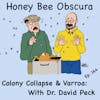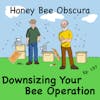Capturing and Hiving Swarms (067)

A beekeeper's most exciting moment is undoubtedly, capturing and hiving a swarm... especially when it is someone else's bees! In today episode, Jim Tew and Jeff Ott - who is filling in for Kim Flottum this week - discuss capturing swarms and how you...
 A beekeeper's most exciting moment is undoubtedly, capturing and hiving a swarm... especially when it is someone else's bees! In today episode, Jim Tew and Jeff Ott - who is filling in for Kim Flottum this week - discuss capturing swarms and how you can be prepared this year.
A beekeeper's most exciting moment is undoubtedly, capturing and hiving a swarm... especially when it is someone else's bees! In today episode, Jim Tew and Jeff Ott - who is filling in for Kim Flottum this week - discuss capturing swarms and how you can be prepared this year.
How can you be prepared? Get some basic equipment pulled together. A container of some type (preferably bee-tight), such as a hive body with a frame or two of brood comb foundation, pruning shears, a tarp - white is best for spotting the queen, a bee suite and veil, a large piece of cardboard, a bee-vacuum, a bucket on the end of a long pole, and maybe a ladder. Some beekeepers keep this equipment or subset, loaded up in their car or truck during swarming season.
Once you find the swarm and figure out your approach, you can typically shake them into your collector or even vacuum them. Each situation is unique so be prepared for just about anything. If you can, ask bystanders or the caller, how long the bees have been in that location. That will largely determine their disposition. Not all swarms are ready for your YouTube moment, capture in flip-flops, t-shirt and shorts. They can be testy, especially if they've been in one location for three or more days.
 There is a great satisfaction in bringing home a box of 'free bees', that are all biologically set to establish a new colony. Especially if they are not your bees!
There is a great satisfaction in bringing home a box of 'free bees', that are all biologically set to establish a new colony. Especially if they are not your bees!
What is your favorite swarm story? What is the most memorable location from which you captured a swarm? Let us know in the comments section of this episode! Start a discussion.
If you like the episode, share it with a fellow beekeepers and/or let us know by leaving a comment in the show notes. We'd love to hear from you!
___________________
Thanks to Betterbee for sponsoring today's episode. Betterbee’s mission is to support every beekeeper with excellent customer  service, continued education and quality equipment. From their colorful and informative catalog to their support of beekeeper educational activities, including this podcast series, Betterbee truly is Beekeepers Serving Beekeepers. See for yourself at www.betterbee.com
service, continued education and quality equipment. From their colorful and informative catalog to their support of beekeeper educational activities, including this podcast series, Betterbee truly is Beekeepers Serving Beekeepers. See for yourself at www.betterbee.com
______________________
Honey Bee Obscura is brought to you by Growing Planet Media, LLC, the home of Beekeeping Today Podcast.
Music: Heart & Soul by Gyom, Walking in Paris by Studio Le Bus, original guitar music by Jeffrey Ott
Copyright © 2022 by Growing Planet Media, LLC

Episode 67 – Capturing and Hiving Swarms
[music]
Jim Tew: Well, podcast listeners, it's that swarming time of the year for some of us. Again, Kim can't be here today with me. I'm Jim Tew and I'm with Jeff Ott.
Jeff Ott: Jim, how are you doing?
Jim: I'm mostly okay, Jeff. Thanks for filling in for Kim again. He'll be back very shortly but while he is away, we wanted to talk about swarming because it's sorting time of the year, and everybody's got a swarm story.
Jeff: Oh, yes.
Jim: If you don't have one, you will.
Introduction: You are listening to Honey Bee Obscura brought to you by Growing Planet Media the folks behind Beekeeping Today Podcast. Each week on Honey Bee Obscura, host Kim Flottum and Jim Tew explore the complexities, the beauty, the fun, and the challenges of managing honeybees in today's world in an engaging and informative discussion meant for all beekeepers, long-timers, and those just starting their journey with bees. Sit back and enjoy the next several minutes as Kim and Jim explore all things honey bees.
Jim: Jeff, have you picked up any swarms this year?
Jeff: No, not yet this year. Last year, I had quite a few. Not yet this year. It's only the beginning of April, so it's pretty early here in the Pacific Northwest.
Jim: Well, for those of us here in the Midwest, it's too early too, but it's not too early to get ready.
Jeff: No.
Jim: The old days, you had swarm left at various meetings and locations. How do you get the call, Jeff, in the Pacific Northwest? How do people let you know there's a swarm there?
Jeff: Well, our local club, the Olympia Beekeepers Association, OBA, we do have a swarm list. One of the ladies in the club is Gail is very good at maintaining that swarm call list, and so she has the county pretty much quartering it off and you let her know where you live, and so she gets a call. If she gets a call during the day, she finds out where the swarm is. She finds the beekeepers in that list in that area and gives them a call to go get it.
Jim: She's an angel because for many years, I'm not allowed to maintain that list, and you think it's a piece of cake. "I'll just call Jeff and tell him there's a swarm there. Jeff, Jeff, Jeff?" Jeff didn't answer. Now, what are you going to do? Well, I'll call the next guy on the list or the next person on the list. You end up spending a lot of time and then you get someone, "Well, I can't go I'm at work." Then you keep going down the list.
Then the next time you say, "I'm at a meeting," they'll say, "Well, you never called me I really wanted a swarm." "Well, actually, I did call you and you didn't answer." It never works as smoothly if you're the caller. I have been the caller, but they serve a very viable purpose. It was my experience that once you get that call, one of the first things you're going to want to know is how long they've been there?
Jeff: Yes, definitely. Nothing's more frustrating to get to someplace and find out, "Oh, well, that was yesterday, they were here."
Jim: Oh, yes, they left. They didn't stay here very long at all, but I should have called you, shouldn't I? When I get another swarm, I'll think to say you're there the next time. How long have they been there? Even if they've just landed as you know, that doesn't mean anything. They may be there for just a few minutes or they may hang there for three days.
Jeff: It's a good thing to ask is how long have they been there?
Jim: If they're one of those three dayers, you really want to know that because when you walk up with your box and your good attitude, and you shake that limb with a swarm that's been hanging there, pretty much used up its food reserves, it can be a jpeg moment for you. They can put you back under the truck that you came in.
Jeff: If it's been cold after they swarmed and it turned cold or rainy and they've been up there for three or four days like you said, you're not going to want to be there and your shorts and T-shirts and no veil to hive them.
Jim: Putting on a demonstration for all the neighbors.
Jeff: [laughs] Your TikTok moment.
Jim: That's called a dry swarm. Why don't you put down? You told me you'd like to put down something to shake the swarm on to if it's close to the ground. Tell the listeners about that.
Jeff: The bees will land wherever the queen decides to land. There's never the perfect moment. Rarely do you find the perfect opportunity where a swarm is just there four feet from the ground on a branch, it's by itself and just hanging there in a big ball that you can just put a box underneath, shake, and walk away. It's usually intertwined in a chain-link fence, or in a bunch of briars, or the worst possible location. I like to take with me a couple of different things. I have a big white canvas, painter's drop cloth, that is really handy to have because if you shake the bees off out of the tree, or off the branch, or off the fence, you can see them a lot easier on that tarp than in the grass.
The second piece is a piece of cardboard because if they're somewhere where you can shake them, and they can slide down the cardboard into a box or onto whatever you're collecting them in, that is a lot handier than on the grass as well.
Jim: I think that's a great idea that causes the trick what you're trying to do. If you found the queen, you pretty much have narrowed it down, you're going to keep most of those bees. Even in a normal swarm, some of those bees are going to return back to the parent colony. Give it a shot, decide this is not for them, they're going to go back home, but most of the bees will stay. If you got the queen in a cage, contain her there, keep them there overnight for a day or two, move them away, you can disrupt their previous plans that they had for maybe another home site they had already found. How often do you say you catch the queen in a swarm?
Jeff: Oh, I'd say less than 50% of the time. Again, I'm your typical harried beekeeper, and that I don't have a whole lot of time on my hands. I usually get there, I want to get them in a box or gathered up and leave. I don't sit there and try to find the queen. If I am able to shake them into a box, and I'm watching them and they do the lineup and start marching into the hive body that I have sitting there, I'll watch for the queen, but I'd say less than half the time. Yourself?
Jim: I would go with 30%. I always look, but what's been my experience and she's probably going to be on the outside of the cluster dashing around, she's really fast and flighty. Even if you see her, you got bees flying all around you. You're dealing with arriving living mass of bees and you've got one bee that you're trying to pick up carefully, gently by her thorax or by her wings, and then put her into a queen cage that you miraculously have there with you.
In the old days, we all had those little push-in matchboxes, but those are all gone now for the most part. You have to really plan for her if you think you're going to be a queen grabber. I may see them 50% of the time, but I can't always catch them. They're just too quick. She will just like lightning, work her way inside that swarm and then she's basically gone. You're back to starting all over again.
Jeff: One of the handy things to carry with you on these calls if you can think of it this is one-handed queen catchers. Whether it'd be the snap trap or those new contraptions.
Jim: That's a good point and I don't carry those.
Jeff: No and I used to carry that little PVC queen cage that you made long ago. I had a whole bunch of those because I ended up buying a big length of PVC pipe, [chuckles] ended up making a bunch of this.
Jim: You have never told me that. You're the only consumer of my queen cage design and I just made mine from scrap and lost it.
Jeff: I keep looking for it here. I wondered if it followed me out west. Hey, speaking of those queen cages and queen catchers, you can pick them up at any bee supply store such as Betterbee, our sponsor of the show today.
[music]
Betterbee: Betterbee is pleased to sponsor today's episode of Honeybee Obscura Podcast. For over 40 years, Betterbee has supplied beekeepers across the country with the tools, equipment, and knowledge needed to succeed. Because many Betterbee employees are beekeepers themselves, they understand your needs and challenges and are better prepared to answer your beekeeping questions. From their colorful catalog to their supportive beekeeper educational activities including this podcast, Betterbee truly lives up to their tagline of beekeepers serving beekeepers. See for yourself at betterbee.com
Jim: One of the things that I wanted to tell people that they know already, but when you go out that afternoon and there's that swarm and it's 30 feet in the air, and you've got a 12 foot A-frame ladder and you've got an extendable paint pole. If you put that ladder in the back of your truck, you could probably just barely reach it. I want to remind everyone that at that moment, most of us are not going to be rational. Having been the man in the back of that truck on top of that ladder, the truck suspension system sways, and you turn into a carnival act up there and it can really be dangerous with you doing that kind of thing.
Even though it's free bees and even worse, it's your bees that are up there, you really shouldn't do anything that is going to endanger yourself. Now, that's coming from an old man who doesn't have enough time left to spend a lot of time healing. If you're a younger person and you think you've got years to go through recovery, then you might want to do some of these things. It's easy to get carried away as I have done and I have pictures of others doing things they should not have been doing to retrieve a swarm.
Jeff: It definitely sounds like a Clark Griswold moment on the ladder.
Jim: It's like here, hold my beer a moment kind of thing. I can do this.
Jeff: I can do this. [laughs] Can someone get a picture?
Jim: Somebody bring me my rifle.
Jeff: You shot swarms or you shot--
Jim: I have been part and parcel. I wasn't the shooter. It's more difficult than you'd think to shoot straight up, plus you shouldn't be doing that anyway. Where's that round going to fall? In case you've got that thought, let me tell you that when you finally do shoot the limb off if that was your goal, the swarm is going to break apart before it hits the ground, and they're going to probably go right back and cluster on that stub of where you just shot to lay them off.
The main thing you did was caused a lot of noise and ruckus and upset the neighbors that afternoon. A quieter approach that beekeepers like to try is using archery equipment and firing a lead line over the limb and then maybe towing a frame up or towing a bucket up or towing something up after you've shot the lead line over, pull a heavier line up with that, and then somehow you miraculously have this bucket or this comb or whatever you're trying to use as a lore way up top that you can lower the swarm back down. These are all examples of the extremes that we all go to, to get those bees down.
Jeff: I don't do the extreme stuff. I've been instructed no ladder. If it's up there too high, I just have to wave goodbye and keeping monitoring them, and maybe they'll come down or go to a different location that I can access them. If they're too high, I don't personally go after them. One of the things that is very useful is a buddy of mine took a five-gallon water jug from a cooler, cut off the bottom, a plastic one, plugged it into an end of a paint pole using foam or glue or something.
You could extend that up underneath the colony and you can just bump it up and bring it down. If you can aim right, you can get it into the hive box, whatever you're collecting them in, on the ground. That works out really well, no ladders involved.
Jim: Jeff, what Kim, and I often say and I'd like to say it now, we obviously don't rehearse, this is a live conversation. I have done that and I practice. I'll take my bucket and my extended rod and I'll set up a target. It may be 16, 18 feet away. I'll put my hive there and then once I have the bees in the bucket, I'll let that art fall toward the bucket because I can't get it down. I can't control it. The bucket is swaying all around, the pole is overloaded, and bees are flying everywhere, and the neighbors are taking pictures of all of this.
You want to look like you have an idea of what you're doing. Do you understand what I mean? I practice where I'm going to drop the bucket. I try to have the beehive very close to that. Actually, if you want to, hit the hive. The top is off and there's a comb right there and see if the queen can survive that fall.
Jeff On top of your tarp so they're not all crawling through the grass.
Jim: You're right, and that high box should be on a tarp to keep from losing the queen in the grass.
Jeff: I found that a very safe and successful way of getting those swarms up in the tree branches.
Jim: In preparation for this talk, I did look it up. You can borrow those extension paint roller handles routinely 6, 8, 10, 12 feet long, but if you're really serious about this, you can get up to 26 feet long. If you get to the electrical business where they're using these really heavy-duty poles at the base, they're three inches in diameter and you can go up 25 or 30 feet, but what are you going to do when they get that high? It's like a carnival light then.
You can really reach a lot from the ground if you think you can do anything once you got that high. Jeff, I frequently use a swarm vacuum. It just vacuums bees in general. They're really useful at times. There's so many different models that I'd almost like to revisit this sometime, but for now, are you a vacuum kind of guy?
Jeff: [laughs] I am when my wife asks me to, usually the living room. I'll tell you what, Jim, I did an article for Kim years ago for bee culture on a swarm retriever. I used it improperly and I killed the swarm because they got plugged in the hose. Ever since then, and that was totally operator error. I'll take full blame for that. I've not gone back to swarm vacuum. I know there's a lot of different designs and people really like them, but I don't use them.
Jim: I've used them a lot and I too have killed swarms. The way I killed mine was I made the free fall too great. I kept adding PVC pipe and I put the vacuum line on about 15 feet of PVC pipe. Then I had a long, long extension on my vacuum line. The freefall was too much, I guess because what I ended up with was about four pounds of pretty much macerated bees in my trap. There's a limit to how much you can vacuum, vacuum pressure, how far the bees can fall before the fall kills them.
Like I said, maybe more about this later, because there's all kinds of traps and designs and uses and overheating bees and the things you can do, but swarm vacuums are available. The other thing is, just quickly, you can hive them at night. They call some, but if you get the call and it's close by, go get them at night. It doesn't have to be in the daytime, especially if they're close to the ground. What are you going to put them in when you get them?
Jeff: Personally, if I can, I have a hive body that's all set for capturing swarms. I've screwed the bottom board to the bottom hive box. I have set up with a screen front so that I don't have to worry about the bottom separating or anything. Then that box, I have a frame or two of foundation or old brewed comb. I put them in there and then once they settle down, I can put the lid on or the inner cover and the lid, and it's all set up and screened so they don't suffocate. I carry them away and I'm ready to transfer them into a regular hive body.
Jim: You are my idol. I run out and I think, "Oh my stars, I got the call. I got to go. What can I get? What can I take?" I take the first new box. I grab anything I can and I take off because they're going to be gone before I can get there. I'm not that prepared. I actually bought a collapsible laundry hamper from IKEA. The thing falls totally flat and when you open it up, it's about the size of a five-gallon bucket and it has a lid on it and a strap for taking it to the laundry. It made a perfect swarm capturing cage.
Jeff: That sounds really good.
Jim: I sound like I'm selling these things. You find them anywhere you want. It was a collapsible laundry container, you can put whatever you want into it. I chose to put bees into it, which probably wasn't on the original designer list. You don't want to pitch, put them in your veil. Just shake them out into your veil, tie the veil string off, and get them off to the bees' home, and deal with it then.
Jeff: You mean after you take your jacket off or your veil off?
Jim: Yes, after you get out of public view probably. My dad, I loved him dearly I don't have him anymore. He just cut the limb off and put it in the back of his Toyota van, [laughs] drove four pounds of bees home in the back of the van. He said, "It's traffic light." He did get some startled looks from the car sitting next door to him, with him, with his window there with 30,000 bees all around him. Here's a true story, he got home and he just put a hive in the back of the car and yes, he got the swarm.
That's the only time that I can tell this story that such a bizarre thing worked and my dad did it and of course, he was very pleased with himself as he should have been.
Jeff: It's a wonderful story. You can use a ready-made hive retrieving box, a collapsible laundry bag, a veil, or even the back of a Toyota minivan?
Jim: Yes, it has to be a Toyota.
Jeff: [laughs] Well, we'll try to get Toyota as a sponsor for this episode.
Jim: Somebody should ask, "What happened if the queen goes out of the van?" She's gone, you're going to lose the whole thing. That was really a desperation thing dad did. That was just for comic relief in our story here. Don't try that at home beekeepers.
Jeff: I will add one last thing here is that you can use a cardboard box too. I remember a beekeeper had a backyard full of boxes of captured swarms and he says, "I can't hive them all." My buddy and I, he said, "You guys can take whatever you want." I tell you what, they were full of the best linden honey I've ever had. The snow-white comb and it was just packed full of honey because he had all these linden trees in his backyard. It was just wonderful. Anyway-
Jim: Oh, what a story.
Jeff: -beekeeper stories.
Jim: I love beekeeper stories, they're like fishing stories. They get better as the years pass. We can talk about this for 40 more minutes. We've gone on too long. I love talking about it. This is a good part of beekeeping is the excitement of the swarm season.
Jeff: Of someone else's swarms.
Jim: Someone else's just swarms. I like hiving yours.
[music]
Jim: I always appreciate the listeners who let us ramble on and on and tell our stories and reminisce. Thanks to them and thanks to the sponsors, and thanks to you, and looking forward to having Kim back even though I enjoy your company.
Jeff: Well, thank you. I appreciate being here. Listeners can leave your comments and your swarm stories in the comments in the show notes on this episode. We'd love to hear from you. Start a discussion, we'll jump in, and share a few more of ours. Thanks a lot.
Jim: Bye-bye.
[00:22:45] [END OF AUDIO]
New to Honey Bee Obscura Podcast?
Here are some great episodes to start with. Or, check out episodes by topic.













